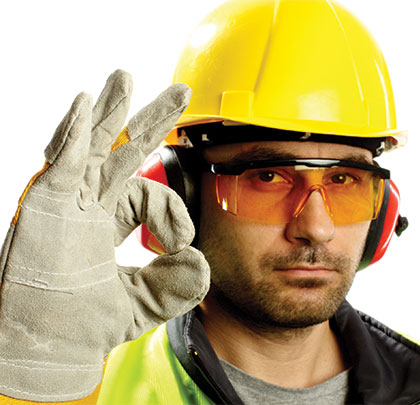Construction companies invest more time and money in worker safety today than ever before. Safety management is now a key strategic consideration at major construction companies and many of these companies have at least one safety representative on each jobsite. Twenty-three of the ENR Top 25 Contractors have either publicly stated goals of reaching zero incidents, zero accidents, and/or getting every employee home safely each day—the language varies—or have committed to building a zero injury philosophy and/or culture.
FATAL STATISTICS
With the industry’s leading companies committing their resources to safety, construction worker injury and fatality rates should be improving by leaps and bounds. Yet in 2013, according to the “CFOI Chart Package” and “Construction: NAICS” from the U.S. Bureau of Labor Statistics, 856 deaths and over 300,000 injuries occurred in the U.S. construction industry. Although these numbers represent a significant improvement over the injury and fatality rates prior to the establishment of OSHA in 1971, on the job injuries and fatalities are not dropping at rates needed for the industry to reach its goal of zero incidents.
According to “Fatal occupational injuries by selected characteristics” from the U.S. Bureau of Labor Statistics, the number of construction fatalities in 2013 was only 8.2 percent less than the number of construction fatalities 20 years prior, in 1993, when 932 construction workers lost their lives on the job. By comparison, AFL-CIO’s “Death on the Job: The Toll of Neglect,” shows that in the 10 years preceding (1983-1993), worker deaths decreased drastically, with 64.1 percent fewer construction workers dying on the job in 1993 than in 1983.
Does the plateau of the last two decades mean that the construction industry’s safety record has gotten as good as it gets? Are more than 800 deaths per year the cost of doing business in this industry? The universal response to these questions is “no;” these numbers are not acceptable. So, how do we advance past the plateau?

ADVANCING PAST THE PLATEAU
First, companies must think beyond compliance. According to Senator Tom Harkin, speaking at a 2012 hearing of the Senate Committee on Health, Education, Labor, and Pensions, “Since the 1980s, it has taken OSHA an average of almost 8 years to put out a final rule.” If companies wait for regulation, the goal of zero incidents may never be reached.
Second, companies must think beyond education. Educating workers on safety is undeniably essential, but safety education is sometimes treated as the only adjustment lever for the industry to reach zero injuries. Perhaps this is because companies are not sure what else to do—they are using the products and following the procedures that OSHA requires, yet injuries are still occurring. Surely, better worker education will get them to their goal?
To make significant safety advancements, safety education must be supplemented by the adoption of safety innovations. Safety innovations are not incremental improvements to existing technologies, but rather new products that reimagine what it means to be safe on the job. One product category that has introduced innovations in recent years is centered on the concept of personal active safety.
SAFETY INNOVATION IN ACTION
Personal active safety solutions are products and systems worn by individuals to improve their safety while working in high-risk environments by actively alerting the wearer or those around him of a potentially hazardous situation.
Examples include The Halo Light from Illumagear; Safetemp from Coolshirt Systems; and V22 from StrongArm Technologies. The Halo Light attaches to any hard hat and produces a 360-degree ring of light around the wearer, actively illuminating the wearer and making him visible up to ¼ mile away in all directions without relying on reflectivity of a secondary source of light. It also floods the wearer’s immediate task area with light, making it easier to see obstacles that could result in slips, trips, and falls. The Safetemp Sensor is placed on the wearer’s neck. It monitors an individual’s core body temperature and provides an audible alert when the wearer is at risk of heat exhaustion or heat stroke. The V22 is a lifting vest that provides physical cues to the wearer when he or she is using an improper lifting technique; it enhances the body’s lifting abilities, making proper lifting techniques more natural.
The industry will need many more such innovations to reach its safety goals, but innovation will not do any good if companies wait for regulation to embrace new products. To make significant progress toward zero injuries, companies must be proactive—embracing innovations before they are required. ■
About The Author: Max Baker is the CEO of Illumagear, whose mission is to illuminate people working in high-risk environments, making them safer with innovative products that are defining a new category of safety gear. He can be reached at max@illumagear.com.
_________________________________________________________________________
Modern Contractor Solutions, July 2015
Did you enjoy this article?
Subscribe to the FREE Digital Edition of Modern Contractor Solutions magazine.

Advancing Worker Safety


